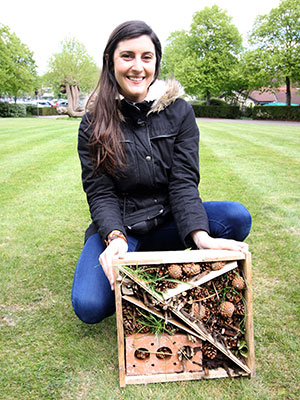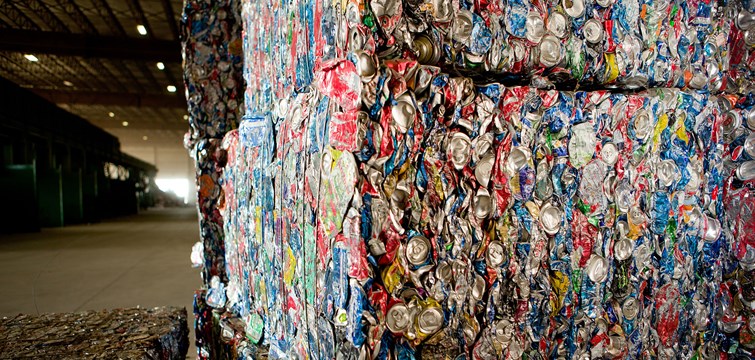As part of our Change for Good project with Avon Wildlife Trust, this month our team created a whole suite of bug hotels to install at Feed Bristol.
It really is very simple and our team had a great time putting them together - we are now excitedly waiting to see who takes up home in them! So why not create one for your own garden or workplace - below are very simple steps to follow to make your own, maybe you can get your office to have a go too?
Materials you will need
You will need untreated or marine grade wood, nails or wood glue, and a saw, to make the box. If you can get hold of a small pre-made wooden box, that will be a lot easier. Off-cuts of wood can be found at building suppliers and pre-made boxes can often be picked up from grocery wholesalers.
You will also need a collection of natural materials, e.g. bamboo, hogweed or fallen elder stems (all of which are hollow), pine cones, bark, and some earth or moss. You might want to add some bricks with holes or slots into the box, which are particularly good for attracting butterflies.

You can also make a bug hotel out of old terracotta pots, tiles or roofing. Upturned pieces of terracotta make particularly good homes for bees. If you add straw under these, they will also attract hedgehogs to hibernate there over the winter. Essentially a bug hotel can be any size, from a mug, to a large construction so let your imagination run wild!!
You can forage for a lot of the inside materials in parks or in your back garden, but make sure you don’t pick bark off any living trees. The best bug hotels are made up of different kinds of materials to encourage lots of different insects, and placed by a bush or tree, to provide warm sections and cooler bits for amphibians and slugs and snails. If you want to attract frogs, toads and newts, they will need a frost free central space to hibernate during the winter.
Let's get started...
Step one
Create a box with a back by nailing together pieces of the wood. You can also use glue, but use it sparingly so as not to introduce too many chemicals into the box and put off the insects.

Step two
Make sure the depth of the wood is 20cm or more to encourage solitary bees to use the box. Halve the box by placing a piece of thin wood diagonally from one end to the other.

Step three
Jam the box full of material. Make sure all the ends of sticks and bamboo etc peek out of the side of the box so creatures can easily get in and out – i.e don’t put them in horizontally. If you do use corrugated cardboard in the hotel, which are useful for attracting lacewings, it needs to be 100% dry and not poke outside. You can use additional pieces of thin wood to mark out different sections of materials to provide greater structure.

Step four
Decaying leaves mimic the woodland floor, and can be put into the gaps, along with pine cones, woodchip and bark.

Step five
Get some soil or moss and wedge into the gaps
Step six
Cut the outward facing material with some secateurs so that it lies flush against the outside of the box.

Step seven
If you particularly want to attract solitary bees then make sure the hollow bamboo or hogweed is no more than 10 mm wide. You can also drill holes in pieces of wood for bees, these must also be 2-10 mm. Bees like to be snug.
Step eight
If you have any old garden shed felt, take some and nail it on top. Alternatively, you can top it off with moss. If you want to improve the habitat further, create a small box the same size as the top, fill it with earth and plant some wildflowers so the insects immediately have a source of food. That's it, all that is left to do is to install it in your garden or green space.
Done!

Pleased with your efforts? Tweet images to @ecosurety with the hashtag #bughotel
To find out more about the Avon Wildlife Trust please visit www.avonwildlifetrust.org.uk

Abigail Warren
Head of Client Services
Abigail joined Ecosurety in 2015 and is now Client services manager, ensuring our team provide valuable support to our clients and look for additional value we can add beyond compliance. She graduated in 2014 with a BSc in Environmental Studies from Suffolk University in Boston, Massachusetts. Her degree is a reflection of her passion for environmental issues, which were evoked while growing up surrounded by the beautiful natural landscape of New England.

Useful links
A provisional agreement has been reached on the EU’s Packaging and Packaging Waste Regulation (PPWR).
Read More >>The world’s first United Nations-backed International Centre of Excellence on Sustainable Resource Management in the Circular Economy will be established in the UK.
Read More >>Impact Recycling is partnering with Syklo Ltd, a circular economy growth company, to build the largest plastic recycling plant in Finland, using innovative BOSS technology.
Read More >>



